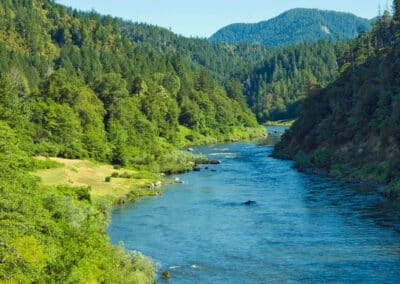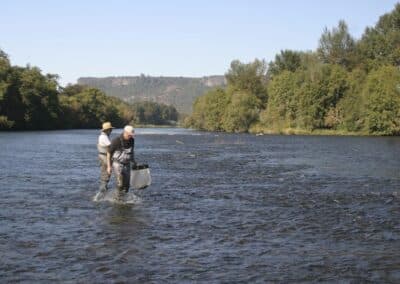Oregon Water Pollution Discharge Permits
Under the Clean Water Act, the U.S. Environmental Protection Agency (EPA) may authorize states to issue permits to dischargers of water pollution. Even so, these permits must meet the requirements of federal law as well as state law. Oregon’s Department of Environmental Quality (DEQ) issues these Clean Water Act permits to all industrial and municipal dischargers in Oregon.
Busting the Myth that Permitted Pollution Sources Have Cleaned Up
There is a myth that so-called point sources—the dischargers that require the Clean Water Act’s National Discharge Pollutant Elimination System (NPDES) permits—are largely controlled and that the nation’s pollution problems are primarily caused by non-point sources, the polluted runoff from lands. While nonpoint source pollution is a major, uncontrolled problem, point sources are far from adequately controlled.
There are many reasons for this. First, the EPA is required to establish minimum treatment standards to ensure that pollution is minimized no matter where the source is located. But EPA has been very slow to complete and to update these national effluent guidelines. And EPA has not increased the requirements for municipal dischargers for many years despite its having concluded that towns and cities are a major source of nutrient pollution that is not removed through use of the currently-required minimum technology called “secondary treatment.” Oregon does not step into the breach; the DEQ is more than willing to let polluters keep polluting. In fact, the Oregon DEQ ranks 49th among 50 states in keeping its permits up-to-date.
Second, states are required to evaluate whether discharges will cause or contribute to violations of state goals, established as water quality standards. Instead, states like Oregon devise creative work-arounds to federal regulations and often ignore them altogether. Oregon is so determined to use this approach that it finds itself unable to issue many permits at all. And, when it does, few DEQ contain permit limits that require dischargers to install pollution controls. DEQ permits also suffer from a long-term failure to ensure that permittees are required to monitor their discharges and the quality of the water into which they discharge. As a result, there are never sufficient data upon which to issue new permits.
permit limits that require dischargers to install pollution controls. DEQ permits also suffer from a long-term failure to ensure that permittees are required to monitor their discharges and the quality of the water into which they discharge. As a result, there are never sufficient data upon which to issue new permits.
Third, there is the EPA-devised concept of “mixing zones.” Even though permits are required to prevent dischargers from causing or contributing to violations of water quality standards, Ecology routinely includes mixing zones—areas of rivers and marine waters where permittees may lawfully violate standards. There is a saying that “dilution is not the solution to water pollution” but, in fact, it is the solution preferred by DEQ and EPA. NWEA even had to go to court to dump a rule in which DEQ proposed to allow mixing zones that would be miles long!
Last, industries located in cities are allowed to discharge into sewage collection systems, diluting their toxic wastes with water from sinks and stormwater from roads. These industries are called “pretreaters” and, while they are subject to some restrictions, they gain significant advantages from this built-in dilution. States, such as Oregon, could increase requirements on such pretreaters to restrict pollution beyond federal requirements, but they do not. When Oregon adopted new human health criteria in its water quality standards that made them particularly stringent, NWEA urged the DEQ and its board, the Environmental Quality Commission, to focus on actually getting rid of toxic pollution through increased pretreatment requirements. The request fell on deaf ears.
Oregon Water Pollution Discharge Permits are Broken Two Ways
Oregon water pollution discharge permit program fails in two departments: quality and quantity. These days it’s almost impossible to evaluate the quality of DEQ permits because there are so few issued. Although NPDES permits are valid for five years when they are issued, so long as a permittee has submitted an application in a timely fashion its existing permit will last indefinitely. This is what we call “zombie permits.” Because there is no remedy in federal law for a permit program that comes to a near complete halt when the EPA refuses to step in, NWEA filed suit in state court to resolve the issue of Oregon’s terrible permit backlog in 2017.
Oregon water pollution discharge permits also suffer from terrible quality. Although the Clean Water Act requires that permits not allow discharges to cause or contribute to violations of water quality standards, Oregon routinely issues permits that fail to meet that basic requirement. Even a consultant found that Oregon’s permits often do not reflect the restrictions required by standards and the TMDL clean-up plans that are intended to restrict discharges when a waterbody has already been found to have unsafe levels of pollution.
Oregon Water Pollution Discharge Permits - Related News

Court Wins for Puget Sound & Columbia River

Ashland Sewage Permit Comments

Rogue River Court Victory
Oregon Water Pollution Discharge Permits – Related Documents
| Petition to OR DEQ for Reconsideration on RUSA | November 21, 2011 | Petition ... | Download |
| Toxic Comments 2011 | March 17, 2011 | toxic comments ... | Download |
| Letter to Oregon EQC Re: Source Control of Dischargers to Municipal Sewage Collection Systems (Toxics) | September 13, 2010 | Letter ... | Download |
| NWEA Memo to Oregon DEQ Re: Source Control of Dischargers to Municipal Sewage Collection Systems (Toxics) | May 26, 2010 | memo ... | Download |
| NEDC NWEA v. EPA (Oregon Compliance Schedule rule) Complaint | September 20, 2007 | Complaint ... | Download |
